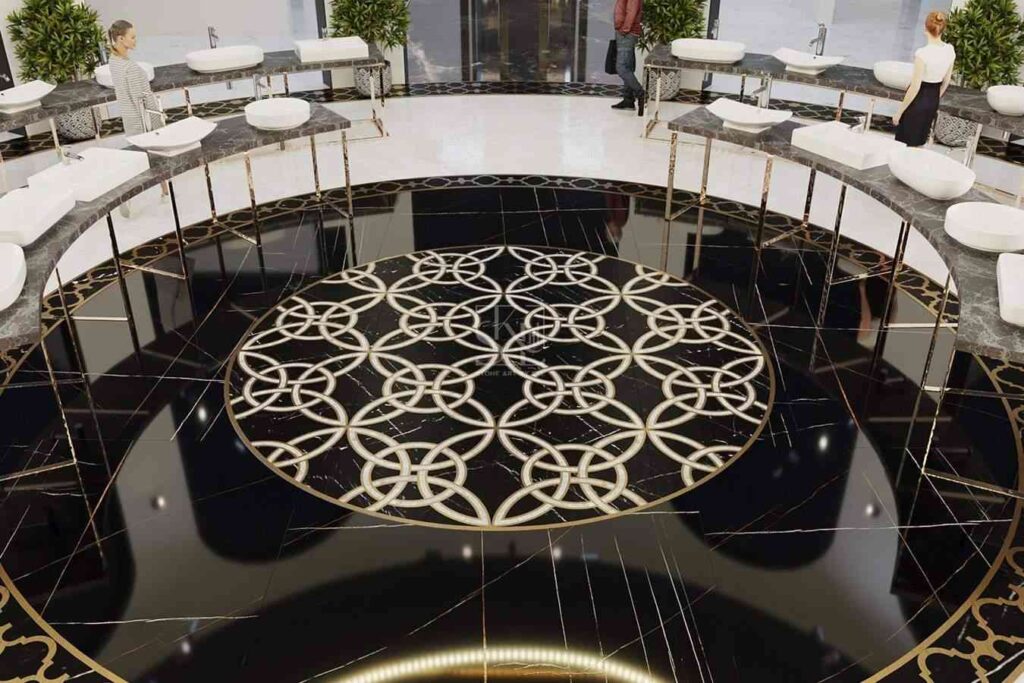Inlay flooring is an art form that combines various materials, such as stone, wood, and metal, into intricate floor designs. This technique elevates spaces by adding textures, patterns, and personalized motifs to floors, transforming them into stunning visual features. Unlike standard flooring, inlay floors serve as a focal point, combining functionality with artistic expression.
What is Inlay Flooring?
Inlay flooring involves embedding materials into the floor to create patterns, ranging from geometric shapes to complex motifs. This technique dates back centuries and has been associated with architectural luxury and artisanal craftsmanship. Inlay flooring Designs are both durable and visually captivating, blending with various architectural styles and personal preferences.
Benefits of Inlay Flooring
- Unique Aesthetics: Inlay flooring allows for custom patterns, giving each space a distinct character. Depending on the material used—such as marble, wood, or metals—the look can range from classic to modern.
- Enhanced Space Definition: Inlay designs can define specific areas within open spaces. This technique is especially useful in large rooms, entryways, and hallways where the patterns can guide movement or indicate focal areas.
- Artistic Craftsmanship: Crafting inlay floors involves skill and attention to detail, with each piece carefully chosen and set to achieve the desired pattern. These floors showcase the artisan’s expertise, resulting in a highly refined finish.
- Durability: Stone and metal inlays, particularly with marble or granite, are highly durable and resilient, making them suitable for high-traffic areas. Quality inlay flooring can last for decades with proper care, adding timeless beauty to a space.
Popular Styles and Patterns
Inlay flooring offers a vast range of styles, from classic medallions and floral motifs to geometric shapes and contemporary designs. Here are some notable design categories:
- Geometric Patterns: Clean lines and shapes like hexagons or trapezoids give a modern, sophisticated look. These patterns are often chosen for minimalist or modern interiors.
- Floral and Organic Motifs: Floral designs are popular in traditional settings, adding elegance and a touch of nature to the floor. These motifs are often used in rooms aiming for a refined, classic ambiance.
- Abstract Art: For a bold statement, abstract inlays create a unique, artistic effect, giving spaces a distinct personality. Abstract patterns are ideal for those who want a more individualized look.
Materials in Inlay Flooring
The choice of materials affects not only the look but also the durability and maintenance requirements of inlay floors. Some popular materials include:
- Marble: Known for its elegance, marble offers a refined, polished look that suits both traditional and contemporary spaces.
- Granite: A highly durable option, granite is perfect for high-traffic areas and is resistant to scratches and stains.
- Wood: Wood inlays are often used to create warmer tones and a more natural aesthetic, especially suitable for residential spaces.
- Metal: Metal inlays, such as brass or copper, add a sleek, modern touch and can accentuate patterns for a more luxurious appearance.
Practical Considerations
While inlay floors are visually stunning, they do require careful planning, especially during installation and maintenance.
Installation
The process of inlaying materials is meticulous, as each piece must be set precisely to align with the design. It’s advisable to work with skilled professionals for inlay installation, as the complexity of the design can impact the timeline and cost. Preparation of the subfloor is crucial to ensure that the inlay materials adhere correctly and stay level.
Maintenance
Maintenance of inlay floors largely depends on the materials used. Here are some general guidelines:
- Regular Cleaning: Dust and debris should be removed regularly to prevent scratching. A soft brush or vacuum can be used to maintain a pristine appearance.
- Avoid Harsh Chemicals: Marble and some other materials can react negatively to acidic cleaners, causing discoloration or etching. Always use products recommended for specific materials.
- Polishing and Sealing: Stone inlays may require periodic polishing or sealing to maintain their luster, especially in areas with heavy foot traffic.
Designing with Inlay Flooring
Inlay floors are not just about decoration they can influence the perception and layout of a space. Here’s how inlay flooring can enhance various areas of a home or building:
- Entryways and Lobbies: Inlay patterns in entry areas can create a welcoming atmosphere, giving a first impression of elegance and thoughtfulness.
- Living Rooms and Open Spaces: Inlays can help break up large areas, providing visual boundaries and guiding foot traffic without the need for physical dividers.
- Bathrooms and Kitchens: Inlay flooring adds a layer of sophistication to bathrooms and kitchens, where marble or granite inlays can complement tile work and cabinetry.
The Lasting Appeal of Inlay Flooring
Inlay flooring is a blend of art and architecture, bridging the gap between functionality and beauty. Each inlay piece represents a commitment to craftsmanship, and the final product reflects the vision of both the designer and the homeowner. For those who appreciate the finer details in design, inlay floors offer a unique, lasting way to personalize and elevate any space.
Through the meticulous combination of materials and patterns, inlay flooring continues to be a celebrated choice for those seeking a timeless, elegant touch in their interiors.






More Stories
Elevate Your Outdoors with a Paving Contractor Bournemouth
SEO Services in Chicago Rank Higher and Accelerate Business Growth
Why Choose the PADI Shore Diver Course? Benefits & Advantages